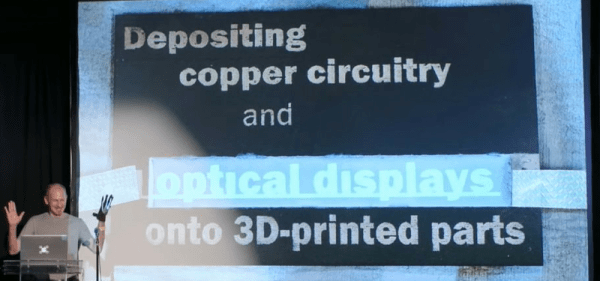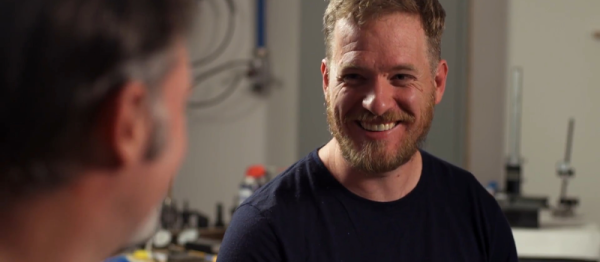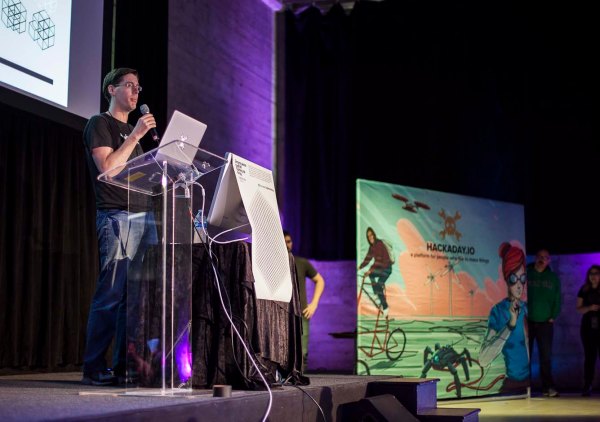Ben Krasnow has a vision of future electronics: instead of the present PCB-screwed-into-a-plastic-box construction, flexible circuits will be deposited straight onto the plastic body of the device itself, merging the physical object and its electronics. There is existing copper-on-plastic technology, but Ben’s got something novel that he presents in this talk that you could implement yourself. You might also want a display, or at least something to blink, so he’s also working on some electroluminescent technology to complement it. If you were wondering why Ben is so interested in silkscreening photopolymers right now, watching this talk will pull a lot of interesting threads together. Continue reading “Ben Krasnow At Supercon: Making Alien Technology In Your Own Shop”
talk24 Articles
Scotty Allen Visits Strange Parts, Builds An IPhone
Scotty Allen has a YouTube blog called Strange Parts; maybe you’ve seen his super-popular video about building his own iPhone “from scratch”. It’s a great story, and it’s also a pretext for a slightly deeper dive into the electronics hardware manufacturing, assembly, and repair capital of the world: Shenzhen, China. After his talk at the 2017 Superconference, we got a chance to sit down with Scotty and ask about cellphones and his other travels. Check it out:
The Story of the Phone
Scotty was sitting around with friends, drinking in one of Shenzhen’s night markets, and talking about how bizarre some things seem to outsiders. There are people sitting on street corners, shucking cellphones like you’d shuck oysters, and harvesting the good parts inside. Electronics parts, new and used, don’t come from somewhere far away and there’s no mail-ordering. A ten-minute walk over to the markets will get you everything you need. The desire to explain some small part of this alternate reality to outsiders was what drove Scotty to dig into China’s cellphone ecosystem.
Continue reading “Scotty Allen Visits Strange Parts, Builds An IPhone”
34C3: Fitbit Sniffing And Firmware Hacking
If you walked into a gym and asked to sniff exercise equipment you would get some mighty strange looks. If you tell hackers you’ve sniffed a Fitbit, you might be asked to give a presentation. [Jiska] and [DanielAW] were not only able to sniff Bluetooth data from a run-of-the-mill Fitbit fitness tracker, they were also able to connect to the hardware with data lines using test points etched right on the board. Their Fitbit sniffing talk at 34C3 can be seen after the break. We appreciate their warning that opening a Fitbit will undoubtedly void your warranty since Fitbits don’t fare so well after the sealed case is cracked. It’s all in the name of science.
There’s some interesting background on how Fitbit generally work. For instance, the Fitbit pairs with your phone which needs to be validated with the cloud server. But once the cloud server sends back authentication credentials they will never change because they’re bound to to the device ID of the Fitbit. This process is vulnerable to replay attacks.
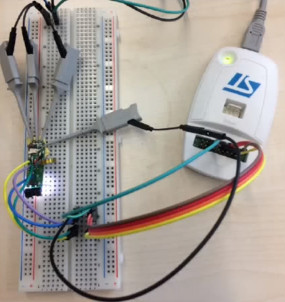 Data begin sent between the Fitbit and the phone can be encrypted, but there is a live mode that sends the data as plain text. The implementation seemed to be security by obscurity as a new Bluetooth handle is used for this mode. This technique prevents the need to send every encrypted packet to the server for decryption (which would be for every heartbeat packet). So far the fix for this has been the ability to disable live mode. If you have your own Fitbit to play with, sniffing live mode would be a fun place to start.
Data begin sent between the Fitbit and the phone can be encrypted, but there is a live mode that sends the data as plain text. The implementation seemed to be security by obscurity as a new Bluetooth handle is used for this mode. This technique prevents the need to send every encrypted packet to the server for decryption (which would be for every heartbeat packet). So far the fix for this has been the ability to disable live mode. If you have your own Fitbit to play with, sniffing live mode would be a fun place to start.
The hardware side of this hack begins by completely removing the PCB from the rubber case. The board is running an STM32 and the team wanted to get deep access by enabling GDB. Unfortunately, the debug pins were only enabled during reset and the stock firmware disables them at startup (as it should). The workaround was to rewrite the firmware so that the necessary GPIO remain active and there’s an interesting approach here. You may remember [Daniel Wegemer] from the Nexmon project that reverse engineered the Nexus 5 WiFi. He leveraged the binary patching he used on Nexmon to patch the Fitbit firmware to enable debugging support. Sneaky!
For more about 34C3 we have a cheatsheet of the first day and for more about Fitbit security, check out this WAV file.
Continue reading “34C3: Fitbit Sniffing And Firmware Hacking”
Anouk Wipprecht: Robotic Dresses And Human Interfaces
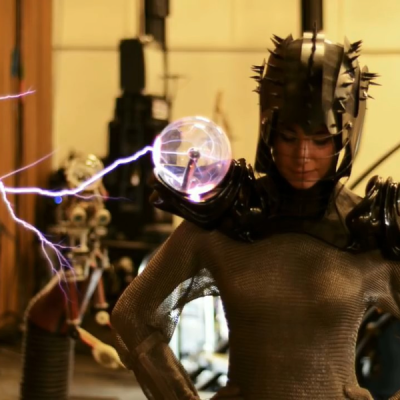 Anouk Wipprecht‘s hackerly interests are hard to summarize, so bear with us. She works primarily on technological dresses, making fashion with themes inspired by nature, but making it interactive. If that sounds a little bit vague, consider that she’s made over 40 pieces of clothing, from a spider dress that attacks when someone enters your personal space too quickly to a suit with plasma balls that lets her get hit by Arc Attack’s giant musical Tesla coils in style. She gave an inspiring talk at the 2017 Hackaday Superconference, embedded below, that you should really go watch.
Anouk Wipprecht‘s hackerly interests are hard to summarize, so bear with us. She works primarily on technological dresses, making fashion with themes inspired by nature, but making it interactive. If that sounds a little bit vague, consider that she’s made over 40 pieces of clothing, from a spider dress that attacks when someone enters your personal space too quickly to a suit with plasma balls that lets her get hit by Arc Attack’s giant musical Tesla coils in style. She gave an inspiring talk at the 2017 Hackaday Superconference, embedded below, that you should really go watch.
Anouk has some neat insights about how the world of fashion and technology interact. Technology, and her series of spider dresses in particular, tends to evolve over related versions, while fashion tends to seek the brand-new and the now. Managing these two impulses can’t be easy.
For instance, her first spider was made with servos and laser-cut acrylic, in a construction that probably seems familiar to most Hackaday readers. But hard edges, brittle plastic, and screws that work themselves slowly loose are no match for human-borne designs. Her most recent version is stunningly beautiful, made of 3D printed nylon for flexibility, and really nails the “bones of a human-spider hybrid” aesthetic that she’s going for.
The multiple iterations of her drink-dispensing “cocktail dress” (get it?!) show the same progression. We appreciate the simple, press-button-get-drink version that she designed for a fancy restaurant in Ibiza, but we really love the idea of being a human ice-breaker at parties that another version brings to the mix: to get a drink, you have to play “truth or dare” with questions randomly chosen and displayed on a screen on the wearer’s arm.
Playfulness runs through nearly everything that Anouk creates. She starts out with a “what if?” and runs with it. But she’s not just playing around. She’s also a very dedicated documenter of her projects, because she believes in paying the inspiration forward to the next generation. And her latest project does something really brilliant: merging fashion, technology, and medical diagnostics.
 It’s a stripped-down EEG that kids with ADHD can wear around in their daily lives that triggers a camera when their brains get stimulated in particular ways. Instead of a full EEG that requires a child to have 30 gel electrodes installed, and which can only be run in a medical lab, stripping down the system allows the child to go about their normal life. This approach may collect limited data in comparison to the full setup, but since it’s collected under less intimidating circumstances, the little data that it does collect may be more “real”. This project is currently in progress, so we’ll just have to wait and see what comes out. We’re excited.
It’s a stripped-down EEG that kids with ADHD can wear around in their daily lives that triggers a camera when their brains get stimulated in particular ways. Instead of a full EEG that requires a child to have 30 gel electrodes installed, and which can only be run in a medical lab, stripping down the system allows the child to go about their normal life. This approach may collect limited data in comparison to the full setup, but since it’s collected under less intimidating circumstances, the little data that it does collect may be more “real”. This project is currently in progress, so we’ll just have to wait and see what comes out. We’re excited.
There’s so much more going on in Anouk’s presentation, but don’t take our word for it. Go watch Anouk’s talk right now and you’ll find she inspires you to adds a little bit more of the human element into your projects. Be playful, awkward, or experimental. But above all, be awesome!
Continue reading “Anouk Wipprecht: Robotic Dresses And Human Interfaces”
23 Superconference Talks You Shouldn’t Miss
November marked our inaugural Hackaday Superconference, something we’ve been wanting to do for a very long time. Hackaday already has a massive and vibrant online community, but until now, we haven’t asked people to come together for a hardware conference that spans a full weekend. The Supercon is Hackaday incarnate, and hundreds of very cool people showed up for a few dozen talks, amazing workshops, and a lot more.
Over the past month, we’ve been putting together a compilation of everything that happened at the first Hackaday Superconference. This includes videos of all the talks, relevant asides, and posts for everything that happened over a two-day conference. Even if you couldn’t make it out to our first con, this great material that should be shared by all.
Below is a YouTube playlist of all the talks. If you’re looking for eight hours to kill over the holiday weekend, well, there you have it. After the break is the complete conference indexed by day and speaker, with links to the talk and accompanying Hackaday post.
We’d like to thank everyone who came out to the first Hackaday Supercon, with a huge shout-out to the speakers, workshop organizers, and volunteers. It couldn’t have happened without the full support of the Hackaday community. That’s good, because we’re going to be doing this again next year.
Continue reading “23 Superconference Talks You Shouldn’t Miss”
Hackaday’s Editorial Vision
I had the honor of speaking at the 2015 Hackaday SuperConference in November on the topic of Hackaday’s Editorial Vision. We are bringing to a close an amazing year in which our writing team has grown in every respect. We have more editors, writers, and community members than ever before (Hackaday.io passed 100,000 members). With this we have been able to produce a huge amount of high-quality original content that matters to anyone interested in engineering — the best of which is embodied in the expansive Omnibus Volume 2 print edition. 2015 also marked an unparalleled ground-game for us; we took the Hackaday Prize all over the world and were warmly greeted by you at every turn. And of course, the Hackaday SuperConference (where I presented the talk) is a major milestone: Hackaday’s first ever full-blown conference.
So this begs the question, what next? What is guiding Hackaday and where do we plan to go in the future? Enjoy this video which is a really a ‘State of the Union’ for Hackaday, then join me after the break for a few more details on why we do what we do.
Neil Movva: Adding (wearable) Haptic Feedback To Your Project
[Neil Movva] is not your average college student. Rather than studying for exams or preparing to defend a dissertation, he’s working on a project that will directly help the disabled. The project is Pathfinder, a wearable haptic navigation system for the blind. Pathfinder is an ambitious project, making it all the way to the semifinals of the 2015 Hackaday Prize. Haptics, the technology of providing feedback to a user through touch, lies at the core of Pathfinder. [Neil] was kind enough to present this talk about it at the Hackaday SuperConference.
Continue reading “Neil Movva: Adding (wearable) Haptic Feedback To Your Project”

